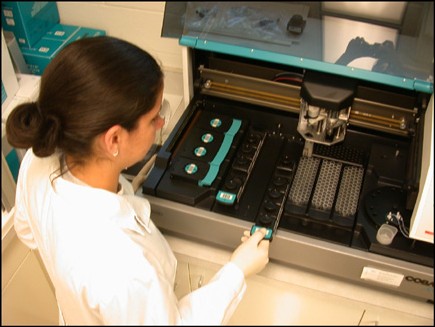When STDs are the question, knowledge is the answer

Image: When STDs are the question, knowledge is the answer:Photo by Natalie Morris/State HornetLorraine Armijos, a student lab assistant at the Student Health Center, tests a blood sample for chlamydia. :
April 16, 2002
Some students use protection when they have sex. Some don?t. But either way, anyone who is sexually active faces the stark possibility of contracting a sexually transmitted disease, whether they?ve been in a long-term relationship with their partner or not.
One of the most important considerations is knowledge of the diseases; one can?t avoid an STD, even though they?re unaware of the symptoms or if their partner is infected.
This is just as true for college students, and the ways Sacramento State students broach the subject are as varied as the students who go here.
Some Sac State students confront their partners early in their relationships about STDs. Sophomore Christina Hake, a dance major, brought up the subject two weeks into her relationship with her boyfriend.
“We discussed our past, and our ex-partners? histories,” Hake said. “We were honest and open.”
Hake suggests students be open when talking with their partners about STDs.
“Sex is not an embarrassing thing,” she said. “Everybody eventually has it.”
Junior Dustin Long, a psychology major, asks for proof of STD testing from his partners before having sex with them. “Papers are the best way. Get a date, too,” he said.
Other students don?t feel the need to get tested for STDs.”I?ve always used protection. [I?ve always had sex] with someone I?m in a long-term relationship with,” said junior Dave Winthan, a psychology major.
“I?m kind of scared of needles,” said sophomore Joel Guevarra, a communication studies student.
Despite the many ways Sac State students respond to STDs, of the 65 million people in the United States who have contracted an STDs, two-thirds are 25 years old or younger.
“There are students with a wide knowledge base on STDs. Some are highly informed, and some are not,” said Laurie Bissett Grady, Director of Health Education at the Student Health Center.
A common misperception about STDs is that they can only be contracted during intercourse and through an exchange of bodily fluids, or when no condoms are used during sex, Grady said.
Genital herpes (herpes simplex virus type two), which causes ulcer or sore outbreaks on the surface of the skin or genital area, can be transmitted through direct skin-to-skin contact, when a contagious area comes into contact with the mouth or genitals. Many infected people have very mild or no symptoms at all, and less than 10 percent of people who tested positive with herpes knew they had the disease, according to the Center for Disease Control and Prevention.
The Human Papillomavirus, the most common STD in the United States, causes genital warts and is spread through direct skin-to-skin contact during vaginal, anal or oral sex with someone infected. Subclinical HPV, more common than genital warts, exhibits no symptoms and can lead to cervical, penile and anal cancer.
Grady advises students to be particularly aware of both of these viral STDs, which have no cure.
“Viruses are different from bacterial infections. A virus waxes and wanes,” Grady said.
Though external symptoms of both diseases may disappear, the viruses can reactivate in subsequent years.
Grady said that the campus? Student Health Center sees more cases of gonorrhea and chlamydia in students than other STDs. Both these STDs will sometimes exhibit no symptoms, or can cause painful urination, penile and vaginal discharge and abdominal pain in women.
Though both diseases are curable, they can cause extensive health problems if left untreated, such as sterility and inflammation of the prostate and epididymitis glands in males, and infertility and Pelvic Inflammatory Disease in females.
Chlamydia levels in Sacramento County reached epidemic proportions in 1996, when the rates were 3.1 percent per 100,000 cases, more than 1.5 times the state average, according to the Sacramento County Public Health Department.
In response to these findings, Grady and other Health Center personnel created the Chlamydia Screening, Education and Treatment project to monitor chlamydia cases among Sac State students and provide free urine testing and treatment. The project later extended to American River, Cosumnes River and Sacramento City Community Colleges.
The CSET project has tested roughly 75 students on campus per week since its start in August 2000, and has almost reached its goal of 4,000 screenings before the project?s scheduled end on May 10.
The CSET preliminary data, as of December 2001, found a 3.2 percent chlamydia rate among 3081 Sac State students.”This information is comparable to what we?d find in county, state and national statistics,” Grady said.
Sacramento county?s chlamydia levels have risen since 1998, to a 3.8 percent chlamydia rate per 100,000 cases as of 2000.
If one thinks they?ve contracted an STD, Grady advises students to “get some type of health service, whether it be from your health care provider, from the county, or here at Sac State.”
The health center currently offers confidential STD testing for chlamydia, herpes, gonorrhea, HPV, molluscum, and syphilis, and both confidential and anonymous testing for HIV.
“Get yourself tested frequently, whether you?re with somebody or not,” Hake said.
“[Tests] ease your mind. It?s comforting if you?re freaking out,” Long said. “It?s also very responsible. Nobody will get pissed off if you do.”
Grady advises students to abstain from sex until they know their own or their partners? health status. “It?s best to wait. “?No? is an appropriate choice,” she said.
Send comments, questions, or concerns to[email protected].
For questions or information regarding the site,please contact [email protected]




























































































































